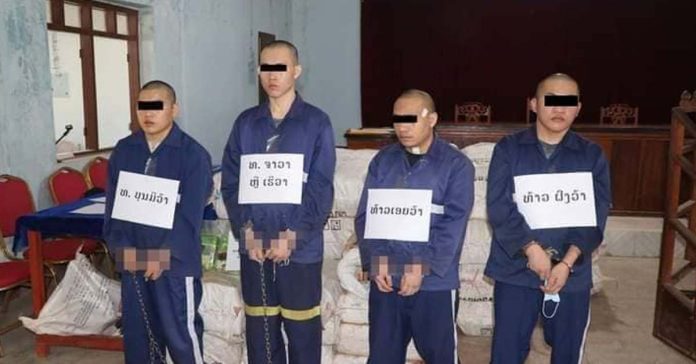According to a BBC report, France ordered Apple on Tuesday to halt iPhone 12 sales in the country for emitting high levels of electromagnetic radiation.
Twelve Annual Festival Highlights that Showcase the Rich Heritage of Laos
Since ancient times, the Lao lunar calendar has celebrated traditional festivals, one per month, in a cycle called Hit Sip Song (the twelve traditions). These are celebrated in different ways in different areas of the country, with some of these rituals nearly disappearing. Get a deeper look at how Lao people honor their customs and build karma throughout the year.
Skyborn receives environmental permit to build 1 GW-Storgrundet Offshore wind farm in Sweden
- Environmental permit for Storgrundet Offshore wind farm
- Generation of 3–3.5 TWh annually
- Contribution to clean energy transition in Sweden
STOCKHOLM, SWEDEN – EQS Newswire – 14 September 2023 – Skyborn Renewables (Skyborn) has received the environmental permit from the Swedish Land and Environment Court to build the Storgrundet Offshore wind farm, marking an important milestone in realizing the project. The permit allows for a maximum of 51 wind turbines, which, when fully operational, will have a capacity of roughly 1 GW and generate 3–3.5 TWh of electricity annually. The operationalization of the Storgrundet offshore wind farm depends on the granting of further permits, including the grid connection permit. The project is planned to be operational before the end of the decade.

“We welcome the Court’s decision, which constitutes a central milestone for Storgrundet Offshore and brings us closer to realizing this long-planned project. We will now focus on securing the remaining permits,” commented Hanna Magnusson, Interim Managing Director of Skyborn Sweden. “At a time when the demand for fossil-free electricity is at its peak, Storgrundet will contribute significantly to Sweden’s clean energy transition.”
The project area is in Gävleborg county, situated about 15 kilometers from the mainland in Gävle and Söderhamn municipalities. It is recognized as a site of national importance for energy production and extraction in Sweden’s marine spatial plans. The electricity production from Storgrundet Offshore will equal roughly 70% of the current electricity demand in Gävleborg county.
Earlier this year, Skyborn submitted two separate permit applications to the Swedish government for offshore wind in the Bothnian Sea, one for Eystrasalt Offshore and one for Fyrskeppet Offshore. In total, Skyborn’s development portfolio in Sweden has a potential power production of 40 TWh annually.
About Storgrundet Offshore:
- Number of WTG: Maximum 51 units
- Capacity: Approx. 1 GW (1,020 MW)
- Production Approx. 3–3.5 TWh
- Location: Approx. 15 km from the mainland in Gävle and Söderhamn municipalities, Gävleborg County, Sweden
- Status: In development
This press release and press photos are available at
skybornrenewables.com/articles/newsroom/storgrundet_enviromental_permit
The issuer is solely responsible for the content of this announcement.
About Skyborn Renewables
Skyborn Renewables is driving global decarbonization by accelerating offshore wind energy across the world. We believe offshore wind is a cornerstone of the clean energy transition and an enabler for achieving net-zero targets, ensuring energy security and developing a sustainable energy supply for future generations. Skyborn is an accomplished offshore wind developer and operator with more than 20 years’ experience. Our capabilities cover the entire offshore wind value chain, including greenfield development, engineering and design, procurement, financing, corporate power purchase agreements, construction management and asset management.
For more information, visit ![]() www.skybornrenewables.com
www.skybornrenewables.com
Cellini Marks 37 Years of Quality Craftsmanship and Unveils Exclusive Anniversary Sale
Unlock a world of savings with Cellini’s exclusive Anniversary Sale. Get ready to double the joy as you enjoy up to S$700 in savings on top of the home-grown designer furniture brand’s regular discounts. Delight in tiered cashback discounts and exclusive bundle offers on everything from Home Packages to Nightingale Premium Mattresses. Don’t let this opportunity slip by; it’s your chance to elevate your living spaces with quality furniture at unmatched prices.
SINGAPORE – Media OutReach – 14 September 2023 – From now till 29 October 2023, embark on a shopping extravaganza like no other during Cellini’s exclusive 37th Anniversary Sale. To celebrate this significant milestone, the most expansive promotion ever is being rolled out for homeowners to immerse themselves in. Revel in exclusive discounts and enticing offers, featuring up to S$700 in instant cashback and purchase-with-purchase deals.

Discover Exclusive Deals and Indulge in Cellini’s Architectural Aesthetic
Prepare for an exceptional shopping adventure at Cellini, where exclusive deals on a wide furniture collection come with an impressive range of tiered cashback discounts, purchase-with-purchase deals and more. Get set to dive head first in the ultimate season of home transformation and fulfil your interior dreams, whether you’re a discerning furniture enthusiast or looking for exquisite additions to elevate your living spaces.
For everything from the Homer Motorised Fabric Recliner Sofa to the Carrara Quartz Top Dining Table with Marble Accents, unlock double the joy as you shop with the added bonus of earning instant cashback on top of regular discounts based on your spending. Redefine your space with these limited-time promotions
| 37th Anniversary Sale | |
| From Now – 29 October 2023 | |
| Minimum Spend | Instant Tiered Cashback Value* |
| S$3000 | S$100 cashback |
| S$4000 | S$200 cashback |
| S$5000 | S$300 cashback |
*Product exclusions and T&Cs apply (Tiered cashback discounts are not applicable for Nightingale Premium Mattress products).
Beyond the appealing instant cashback offers, embrace the world of exquisite craftsmanship and luxury living with sales on a curated selection of the brand’s finest furniture collections and packages.
Transform your living spaces with the versatile Home Package Bundles, specially designed for compact spaces. Crafted for functionality, durability, and affordable luxury, enjoy the freedom to mix and match furniture options in-store. Not only will you save S$400, but you’ll also earn an extra S$300 instant cashback!
For a night of unparalleled rest, consider the Nightingale Premium Mattress. Save up to S$500 in instant cashback when you choose selected mattresses such as Seville Lux, Botania, Natura and Flow from the collection. And for the perfect bedside companion, snatch up the Dansk Bedside Table at just S$37 as a purchase-with-purchase deal (limited to one redemption per bill).
Unlock Incredible Savings at Cellini’s Anniversary Sale
Leading Singapore’s contemporary furniture market since 1986, Cellini is celebrated for its artistic and quality home-grown designer furniture. Its industry excellence is showcased through prestigious accolades, notably the recent “Singapore’s Best Customer Service 2023/2024” Award, which recognises its exceptional service in the premium furniture retail sector. Now, Cellini is thrilled to mark its 37th anniversary with an exclusive sale, delivering what customers truly desire. Whether you’re transforming your living room or upgrading your bedroom, join in the celebration to commemorate decades of quality craftsmanship and design with colossal savings on all your furniture favourites, including the latest furniture collections like the Alba and Fluto Series!
Hashtag: #Cellini
![]() https://www.linkedin.com/company/www.cellini.com.sg/
https://www.linkedin.com/company/www.cellini.com.sg/![]() https://www.facebook.com/CelliniFurniture/
https://www.facebook.com/CelliniFurniture/![]() https://www.instagram.com/cellinifurniture
https://www.instagram.com/cellinifurniture
The issuer is solely responsible for the content of this announcement.
Cellini Singapore
Cellini is a home-grown designer furniture brand in Singapore. Investing in state-of-the-art technology, Cellini’s furniture showrooms boast specially curated pieces that are second-to-none in terms of quality craftsmanship. It has also expanded its services to offer timeless furniture pieces across Asia, in Indonesia, Malaysia, and Taiwan, in addition to making its mark as a successful e-commerce business. For more information, please visit: ![]() https://www.cellini.com.sg/.
https://www.cellini.com.sg/.
Global cities Dubai and Hong Kong forge financial services partnership to activate economic corridor
- Dubai’s Department of Economy and Tourism (DET) and the Financial Services and the Treasury Bureau of the Government of the Hong Kong Special Administrative Region of the People’s Republic of China (Hong Kong, China) sign Memorandum of Understanding (MoU) at the Belt and Road Summit in Hong Kong
- The MoU will facilitate cross-market connectivity, synergy and opportunities in financial services, and support the development of family office hubs and greater collaboration between the two cities in fintech, virtual assets and green and sustainable finance, etc.
DUBAI, UNITED ARAB EMIRATES – Media OutReach – 14 September 2023 – Dubai’s Department of Economy and Tourism (DET) and the Financial Services and the Treasury Bureau of the Government of Hong Kong, China signed a MoU aimed at fostering financial cooperation between Dubai and Hong Kong. The MoU was signed at the Belt and Road Summit in Hong Kong by Hadi Badri and Mr Joseph Chan, the Under Secretary for Financial Services and the Treasury of the Government of the Hong Kong Special Administrative Region.
The MoU represents a strong commitment towards economic partnership in the financial services sector and highlights the intent of the Governments of Dubai and Hong Kong Special Administrative Region to cultivate their bilateral relationship through knowledge exchange and fostering collaboration between their financial markets, thereby contributing to thriving development of the financial services sectors in both cities.
The MoU paves the way for a dynamic partnership, with the two places poised to transform the family office sector’s landscape, strengthen connections and drive cross-market opportunities.
Hadi Badri, CEO of Dubai Economic Development Corporation, Dubai Department of Economy and Tourism: “This landmark agreement MOU is aligned with the financial services priorities of both cities’ governments, and sets the stage for enhanced economic knowledge exchange and collaboration between a range of stakeholders. We are steadfast in our commitment to fostering family office hubs, cultivating enhanced collaboration across capital markets, fintech and virtual assets between the two cities.”
A spokesperson for the Government of the Hong Kong Special Administrative Region said: “The MOU reaffirms the commitment of the Hong Kong Special Administrative Region and Dubai on strengthening the broader relationship and cooperation between the two places, and facilitates the mutual sustainable development of the financial services industries. Furthermore, the MOU will help facilitate policy communication, knowledge exchange and identification of cooperation opportunities in the key areas of financial services industry between the two places, including but not limited to family offices, fintech, virtual asset, green and sustainable finance, etc.”
The MoU will also facilitate the growth of the cities’ Fintech ecosystems, potentially with joint events hosted with relevant agencies, in addition to developing the virtual asset sector. Another key feature of the MoU is accelerating knowledge exchange within the crucial domain of green and sustainable finance, including best practices, product information and nurturing of talent.
The MoU also adds impetus to Dubai’s Economic Agenda 2033, launched by His Highness Sheikh Mohammed bin Rashid Al Maktoum, UAE Vice President and Prime Minister, and Ruler of Dubai, to consolidate Dubai’s status as one of the top three global cities and to double the city’s economy in the next decade.
Hadi Badri said: ” This strategic alliance is another milestone for Dubai and symbolises our commitment towards realising the vision of our leadership’s D33 ambitions to position Dubai as a top 4 global financial capital, as well as building an economic corridor in partnership with Hong Kong, China to generate incremental and sustainable economic growth.
“I am confident that this MoU will provide a platform for greater economic collaboration between stakeholders participating in the family office and financial services industries in both cities. Our focus will remain on harnessing our strengths and capabilities, uncovering novel opportunities within markets, and nurturing the growth of the financial sectors within the emerging economy. We will emphasize on leveraging our unique attributes; exploring innovative markets prospects, and developing out the new economy’s financial sectors.”
This strategic partnership aims to facilitate innovative collaborations between Dubai and Hong Kong, China, encompassing activities such as skill development programs, innovation challenges, research collaboration, and sustainability initiatives. The MoU enables both parties to harness the expertise of financial regulatory bodies, organizations, institutions, and industry representatives, enhancing cooperation and identifying opportunities for joint efforts. This collaboration will streamline the identification and execution of cooperative activities between the two places.
Hashtag: #DepartmentofEconomyandTourisminDubai
The issuer is solely responsible for the content of this announcement.
About Dubai’s Department of Economy and Tourism (DET)
With the ultimate vision of making Dubai, the world’s leading commercial centre, investment hub and tourism destination, Dubai’s Department of Economy and Tourism (DET) is mandated to support the Government in positioning the emirate as a major hub for global economy and tourism, and in boosting the city’s economic and tourism competitiveness indicators. Under this remit, DET is driving efforts to further enhance Dubai’s diversified, innovative service-based economy to attract top global talent, deliver a world-class business environment and accelerate productivity growth. Additionally, DET is supporting Dubai’s vision to become the world’s best city to live and work in by promoting its diverse destination proposition, unique lifestyle and outstanding quality of life, overall.
Four People Killed by Explosive During Dinner Gathering in Luang Prabang
Four people were killed, and two were severely injured, when a grenade went off during a dinner gathering in Nam Bak district, Luang Prabang Province on Wednesday.
OctaFX: Most crucial economic events in the second half of 2023 – Part 1
In this article, OctaFX experts describe three events investors and traders should be aware of. Also, they talk about the impact of Fed decisions on the U.S. dollar exchange rate, the early onset of U.S. presidential election mania, and how India’s wedding season could accelerate the gold price.
KUALA LUMPUR, MALAYSIA – Media OutReach – 14 September 2023 – With the global economy weakening, you may wonder what will impact capital markets in the second half of 2023. Will the U.S. Federal Reserve stop raising rates? What factors will influence dollar and gold prices? What will be the key themes of the year ahead? Several vital stories in the remainder of 2023 are worth considering when investing in global markets.
Fed is expected to slow or pause rate hikes in the remaining 2023
The Fed has raised interest rates 11 times since March 2022 to control runaway inflation, raising its key lending rate in July to the highest level in 22 years. This caused a decline in the U.S. stock market, a rise in Treasury yields, a banking crisis, and a strengthening of the U.S. dollar.
In the first half of September, U.S. Federal Reserve officials said the U.S. central bank can afford to sit tight for now but do not rule out the possibility of another rate hike to fight inflation. According to the CME FedWatch Tool, the probability of a pause at the upcoming FOMC meetings is high, with a 93% probability of holding at the end of the September 2023 meeting and a 58% probability of pause at the end of the December 2023 FOMC meeting.
Investors should keep in mind that business cycles usually outpace economic cycles. Therefore, if a pause is announced at the September FOMC meeting on 19 – 20 September, the U.S. dollar will likely weaken, and stock market prices will rise.
Early onset of U.S. presidential election mania
The next 60th presidential election is scheduled for 5 November 2024. On 15 November 2022, Donald Trump announced the launch of his campaign. On 25 April 2023, incumbent U.S. President Joe Biden announced his candidacy.
Suppose we superficially characterise the two sides of the upcoming election. In that case, it comes out that Donald Trump and the Republicans are committed to traditional values, including being in favour of lowering the tax burden and doing away with non-performing subsidies. At the same time, Joe Biden and the Democrats welcome immigration, equality, and increasing the tax burden on the rich.
Both candidates have already launched their campaigns, meaning the number of political commentaries will increase even before the primary elections in early 2024. In the current situation, the Republicans’ preponderance of votes is perceived as a positive signal for the markets—stock market growth. At the same time, the preponderance of votes favouring the Democrats is perceived as a negative signal—strengthening of the U.S. dollar. Investors should listen to the early signs coming from the U.S. media regarding the presidential election and adjust their investment strategy depending on the emerging early signals.
India’s wedding season could accelerate the gold price
Seasonality strongly influences gold performance throughout the year, particularly with major consumers in India and China who use it for cultural and religious purposes. The period from November to February is a particularly favourable time for the precious metal, which falls in the middle of the wedding season in India. More than half of all gold demand in India is for weddings, which require a massive amount of jewellery, and gold is often seen as a sign of wealth and status among Indians.
With the U.S. Federal Reserve signalling a pause in key rate hikes, the effect of the wedding season could be synergistic—rising demand for gold against a weak dollar will boost gold prices from November 2023 onwards.
We live in an unstable economic and political environment of challenge and turmoil. However, amidst the challenges, there are opportunities for those investors who keep their finger on the pulse of the action. From September 2023 onwards, there will be many opportunities, starting with the U.S. Federal Reserve’s interest rate decision and the wedding season in India. If you want to know more, read the rest of the article in part two.
Hashtag: #OctaFX
The issuer is solely responsible for the content of this announcement.
About OctaFX
![]() OctaFX is an international broker that has been providing online trading services worldwide since 2011. It offers commission-free access to financial markets and various services already utilised by clients from 180 countries with more than 42 million trading accounts. Free educational webinars, articles, and analytical tools they provide help clients reach their investment goals.
OctaFX is an international broker that has been providing online trading services worldwide since 2011. It offers commission-free access to financial markets and various services already utilised by clients from 180 countries with more than 42 million trading accounts. Free educational webinars, articles, and analytical tools they provide help clients reach their investment goals.
The company is involved in a comprehensive network of charitable and humanitarian initiatives, including the improvement of educational infrastructure and short-notice relief projects supporting local communities.
OctaFX has also won more than 60 awards since its foundation, including the ‘Best Online Broker Global 2022’ award from World Business Outlook and the ‘Best Global Broker Asia 2022’ award from International Business Magazine.
Oudomxay Court Sentences Four Men to Death for Drug Trafficking

Four people arrested in November 2020 on drug trafficking charges, were handed a death sentence by the People’s Court of Oudomxay Province earlier this month.





